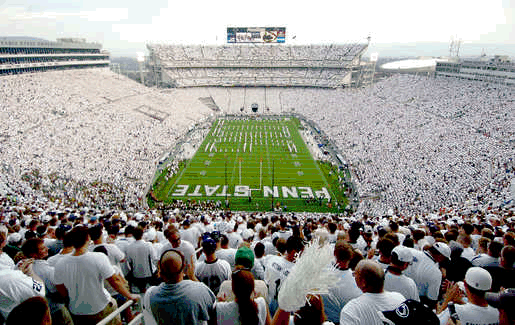During lecture 8 we learned all about monocular cues and how they differ. I found this lecture to be very interesting but I have some difficulty knowing which one is which. To tell the difference I wanted to break down a picture which many students have experienced or at least seen here at Penn State and then discuss one of the cues.

bloguin.com/awfulannouncing/wp-content/uploads/sites/94/2012/07/beaverstadium.gif
In honor of the white out this weekend I wanted to take a classic fan photo of a past PSU white out.
The first thing I wanted to point out in this picture is the difference between the people who were close to the picture and the people whom were farther away. The people close as you can see have some blue hats (and even a green hat). along with this you can see the people and their skin tones. Finally you can notice that there are people wearing different shades of white. Some whites are dull some are shiny and some are a little greyer. Now if you look towards the 50 yard line maybe even closer all you can see is layer of white. you no longer are able to distinguish one person from another. You are now unable to tell if anyone is wearing a blue hat or anything else that would stand out. If you wanted to at the opposite end of the stadium you could tell a handful of people to wear colors that would stick out, like black, red, blue, green, pink, or pretty much any color that isn’t white, and from this view you would still think everyone is wearing white and only white.
Everything I just described is a phenomena called texture gradient. This is a monocular cue which tells us that we see less detail in objects that are further away. This is why we can’t see the blue hats or the skin tones of people at the opposite end of the stadium. If you ever wonder why the people broadcasting the game always include images from high up or far away it’s because those pictures look more dramatic than they actually are.

images.fineartamerica.com/images-medium-large-5/penn-state-whiteout-ghaffari.jpg
Cumberland Valley will face State College in Penn State’s Beaver Stadium on Saturday, Oct. 26
These are some classic examples of pictures that will be shown to you by the people covering the game. In these pictures it looks perfect as if everyone is wearing the correct color and we percieve it this way due to texture gradient.

I really enjoyed reading your blog post! This post was very easy to follow because of the example you used, which for most Penn State students is relatable and made the topic of monocular cues so much more understandable. Also, I never looked at the picture from this viewpoint, like the way you explained it; however, it made me actually think and made the photo so much more interesting than just a photo of the football game. I definitely will use this post to help me remember and understand the texture gradient term. I love the way you broke up the information into the paragraphs because again it made it very easy and simple to understand from a student’s perspective.
First, I have been getting all the cues mixed up and I even messed a few up on the quiz. I will definitely remember texture gradient now because you used the white out as an example which is prevalent to my life since I am so excited for the game this Saturday. I kept associating texture gradient with looking at a picture frame which confused me, but thinking of the stadium and how you can’t see details so far away makes way more sense to me now. I also did not think the blogs helped until I read yours so thank you for helping me remember this cue. Lastly, your post inspired me to make my next few blog posts about something relevant to college kids lives so they can relate to it and remember it for the exam. I may also use this to study by comparing the things I am learning for the exam to real life examples!
I like your post a lot. The pictures of the stadium allowed for a great visual of how the concept of texture gradient works. You did a great job explaining how its easy to differentiate the people closest to the camera. On the other hand, as you look deeper into the crowd, it is harder to see every detail of a person and what they look like. In addition, using a picture from a whiteout game is very useful because it’s already difficult to tell some people apart when everyones wearing white, and especially because there are so many people. However, you pointed out the different shades of white and even some people wearing blue, as well as the physical appearance of people. Your explanations and pictures definitely helped me understand this concept and I’ll always picture the stadium when there’s a texture gradient question!